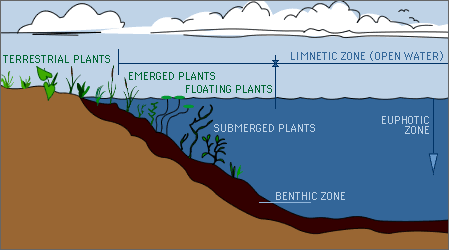 |
 |
A typical lake has distinct zones of biological communities linked to the physical structure of the lake (Figure 10). The littoral zone is the near shore area where sunlight penetrates all the way to the sediment and allows aquatic plants (macrophytes) to grow. Light levels of about 1% or less of surface values usually define this depth. The 1% light level also defines the euphotic zone of the lake, which is the layer from the surface down to the depth where light levels become too low for photosynthesizers. In most lakes, the sunlit euphotic zone occurs within the epilimnion.

Figure 10
However, in unusually transparent lakes, photosynthesis may occur well below the thermocline into the perennially cold hypolimnion. For example, in western Lake Superior near Duluth, MN, summertime algal photosynthesis and growth can persist to depths of at least 25 meters, while the mixed layer, or epilimnion, only extends down to about 10 meters. Ultra-oligotrophic Lake Tahoe, CA/NV, is so transparent that algal growth historically extended to over 100 meters, though its mixed layer only extends to about 10 meters in summer. Unfortunately, inadequate management of the Lake Tahoe basin since about 1960 has led to a significant loss of transparency due to increased algal growth and increased sediment inputs from stream and shoreline erosion.
The higher plants in the littoral zone, in addition to being a food source and a substrate for algae and invertebrates, provide a habitat for fish and other organisms that is very different from the open water environment.
The limnetic zone is the open water area where light does not generally penetrate all the way to the bottom. The bottom sediment, known as the benthic zone, has a surface layer abundant with organisms. This upper layer of sediments may be mixed by the activity of the benthic organisms that live there, often to a depth of 2-5 cm (several inches) in rich organic sediments. Most of the organisms in the benthic zone are invertebrates, such as Dipteran insect larvae (midges, mosquitoes, black flies, etc.) or small crustaceans. The productivity of this zone largely depends upon the organic content of the sediment, the amount of physical structure, and in some cases upon the rate of fish predation. Sandy substrates contain relatively little organic matter (food) for organisms and poor protection from predatory fish. Higher plant growth is typically sparse in sandy sediment, because the sand is unstable and nutrient deficient. A rocky bottom has a high diversity of potential habitats offering protection (refuge) from predators, substrate for attached algae (periphyton on rocks), and pockets of organic "ooze" (food). A flat mucky bottom offers abundant food for benthic organisms but is less protected and may have a lower diversity of structural habitats, unless it is colonized by higher plants.
![]()
|
CREATURES
THAT GO WHERE THEY CHOOSE
|
|||||
|
|||||
|
CREATURES
THAT GO WHERE THE WATER TAKES THEM
|
|||||
|
|||||
|
CREATURES
THAT LIVE ON THE LAKE BOTTOM
|
|||||
|
|||||
Figure 11